A Miniaturized and Highly Stable Frequency-Selective Rasorber Incorporating an Embedded Transmission Window
Abstract
1. Introduction
2. Analysis and Design of FSR Structure
2.1. Theoretical Analysis of FSR
2.2. Structure Design of the FSR
3. Analysis of Simulation Results
4. Experimental Characterization
5. Conclusions
Author Contributions
Funding
Data Availability Statement
Conflicts of Interest
References
- Bai, J.; Yang, Q.; Liang, Y.; Gao, X. Broadband Frequency Selective Rasorber Based on Spoof Surface Plasmon Polaritons. Micromachines 2022, 13, 1969. [Google Scholar] [CrossRef] [PubMed]
- Fan, C.; Duan, K.; Chen, K.; Jiang, T.; Zhao, J.; Feng, Y. Actively tunable rasorber with broadband RCS reduction and low infrared emissivity. Opt. Express 2023, 31, 23294–23308. [Google Scholar] [CrossRef] [PubMed]
- Priyanka, S.; Mohanty, S.S.; Alegaonkar, P.B.; Baskey, H. Design and Manufacturing of a Hexapattern Frequency Selective Surface Absorber for Aerospace Stealth Application. ACS Appl. Mater. Interfaces 2023, 15, 37107–37115. [Google Scholar] [CrossRef] [PubMed]
- Qin, T.; Huang, C.; Cai, Y.; Lin, X. Dual-Band Frequency Selective Surface with Different Polarization Selectivity for Wireless Communication Application. Sensors 2023, 23, 4264. [Google Scholar] [CrossRef] [PubMed]
- Ruan, J.; Meng, Z.; Zou, R.; Cai, F.; Pan, S. Miniaturized Frequency Selective Surface for 6G Communication. Micromachines 2022, 13, 427. [Google Scholar] [CrossRef] [PubMed]
- Niaz, M.W.; Yin, Y.; Zheng, S.; Zhao, L.; Chen, J. Design and Analysis of an Ultraminiaturized FSS Using 2.5-D Convoluted Square Spirals. IEEE Trans. Antennas Propag. 2020, 68, 2919–2925. [Google Scholar] [CrossRef]
- Wei, P.-S.; Chiu, C.-N.; Chou, C.-C.; Wu, T.-L. Miniaturized Dual-Band FSS Suitable for Curved Surface Application. IEEE Antennas Wirel. Propag. Lett. 2020, 19, 2265–2269. [Google Scholar] [CrossRef]
- Mahmoodi, M.; VanZant, L.; Donnell, K.M. An Aperture Efficiency Approach for Optimization of FSS-Based Sensor Resolution. IEEE Trans. Instrum. Meas. 2020, 69, 7837–7845. [Google Scholar] [CrossRef]
- Zhang, Y.; Li, B.; Zhu, L.; Tang, Y.; Chang, Y.; Bo, Y. Frequency Selective Rasorber with Low Insertion Loss and Dual-Band Absorptions Using Planar Slotline Structures. IEEE Antennas Wirel. Propag. Lett. 2018, 17, 633–636. [Google Scholar] [CrossRef]
- Kong, X.; Kong, L.; Jiang, S.; Wang, X.; Zou, Y.; Xing, L. Low-Profile and Dual-Polarization Water-Based Frequency Selective Rasorber with Ultrawideband Absorption. IEEE Antennas Wirel. Propag. Lett. 2021, 10, 2534–2538. [Google Scholar] [CrossRef]
- Qian, G.; Zhao, J.; Ren, X.; Chen, K.; Jiang, T.; Feng, Y.; Liu, Y. Switchable Broadband Dual-Polarized Frequency-Selective RasorberAbsorber. IEEE Antennas Wirel. Propag. Lett. 2019, 18, 2508–2512. [Google Scholar] [CrossRef]
- Liu, N.; Sheng, X.; Zhao, X. Design of Dual-Polarized Frequency Selective Rasorber With Two Independent Transmission Windows Using Multi-Resonators. IEEE Access 2020, 8, 223723–223729. [Google Scholar] [CrossRef]
- Zhang, X.; Wu, W.; Huang, L.; Ma, Y.; Yuan, N. Design of Dual-Absorptive-Bands Frequency Selective Rasorber with Minkowski Loop Arrays. IEEE Antennas Wirel. Propag. Lett. 2019, 18, 1843–1847. [Google Scholar] [CrossRef]
- Kwon, D.H. Lossless Tensor Surface Invisibility Cloaks Utilizing Surface Waves. In Proceedings of the 2018 12th International Congress on Artificial Materials for Novel Wave Phenomena (Metamaterials), Espoo, Finland, 27 August–1 September 2018; pp. 243–245. [Google Scholar]
- Idris, F.M.; Hashim, M.; Ismayadi, I.; Idza, I.R.; Manap, M.; Shafie, M.S.E. Broadening of EM Energy-Absorption Frequency Band by Micrometer-to-Nanometer Grain Size Reduction in NiZn Ferrite. IEEE Trans. Magn. 2013, 49, 5475–5479. [Google Scholar] [CrossRef]
- Costa, F.; Monorchio, A. A Frequency Selective Radome with Wideband Absorbing Properties. IEEE Antennas Wirel. Propag. Lett. 2012, 60, 2740–2747. [Google Scholar] [CrossRef]
- Hu, Y.; Liu, S.; Kong, X.; Mao, C. Low windage resistance frequency-selective rasorber based on windmill-shape coupling line arrays. Electron. Lett. 2017, 53, 1450–1451. [Google Scholar] [CrossRef]
- Omar, A.A.; Shen, Z.; Huang, H. Absorptive Frequency-Selective Reflection and Transmission Structures. IEEE Trans. Antennas Propag. 2017, 65, 6173–6178. [Google Scholar] [CrossRef]
- Wang, L.; Liu, S.; Kong, X.; Zhang, H.; Yu, Q.; Wen, Y. Frequency-Selective Rasorber with a Wide High-Transmission Passband Based on Multiple Coplanar Parallel Resonances. Micromachines 2020, 19, 337–340. [Google Scholar] [CrossRef]
- Zhang, X.; Wu, W.; Ma, Y.; Wang, C.; Li, C.; Yuan, N. Design Dual-Polarization Frequency Selective Rasorber Using Split Ring Resonators. IEEE Access 2019, 7, 101139–101146. [Google Scholar] [CrossRef]
- Yu, Q.; Liu, S.; Monorchio, A.; Kong, X.; Wen, Y.; Huang, Z. A Miniaturized High-Selectivity Frequency Selective Rasorber Based on Subwavelength Resonance and Interdigital Resonator. IEEE Antennas Wirel. Propag. Lett. 2019, 18, 1833–1837. [Google Scholar] [CrossRef]
- Guo, M.; Guo, T.; Cheng, Q.; Zheng, Y.; Fu, Y. Frequency Selective Rasorber with Anisotropic Transmission Band. IEEE Antennas Wirel. Propag. Lett. 2021, 20, 155–159. [Google Scholar] [CrossRef]
- Xiu, X.; Che, W.; Yang, W.; Han, Y.; Xue, Q. A Highly Selective Rasorber Based on Second-Order Resonance. IEEE Antennas Wirel. Propag. Lett. 2020, 19, 223–227. [Google Scholar] [CrossRef]
- Parameswaran, A.; Kundu, D.; Sonalikar, H.S. A Dual-Polarized Wideband Frequency-Selective Rasorber with Low in-Band Insertion Loss and High Oblique Incidence Stability. IEEE Trans. Electromagn. Compat. 2021, 63, 1820–1828. [Google Scholar] [CrossRef]

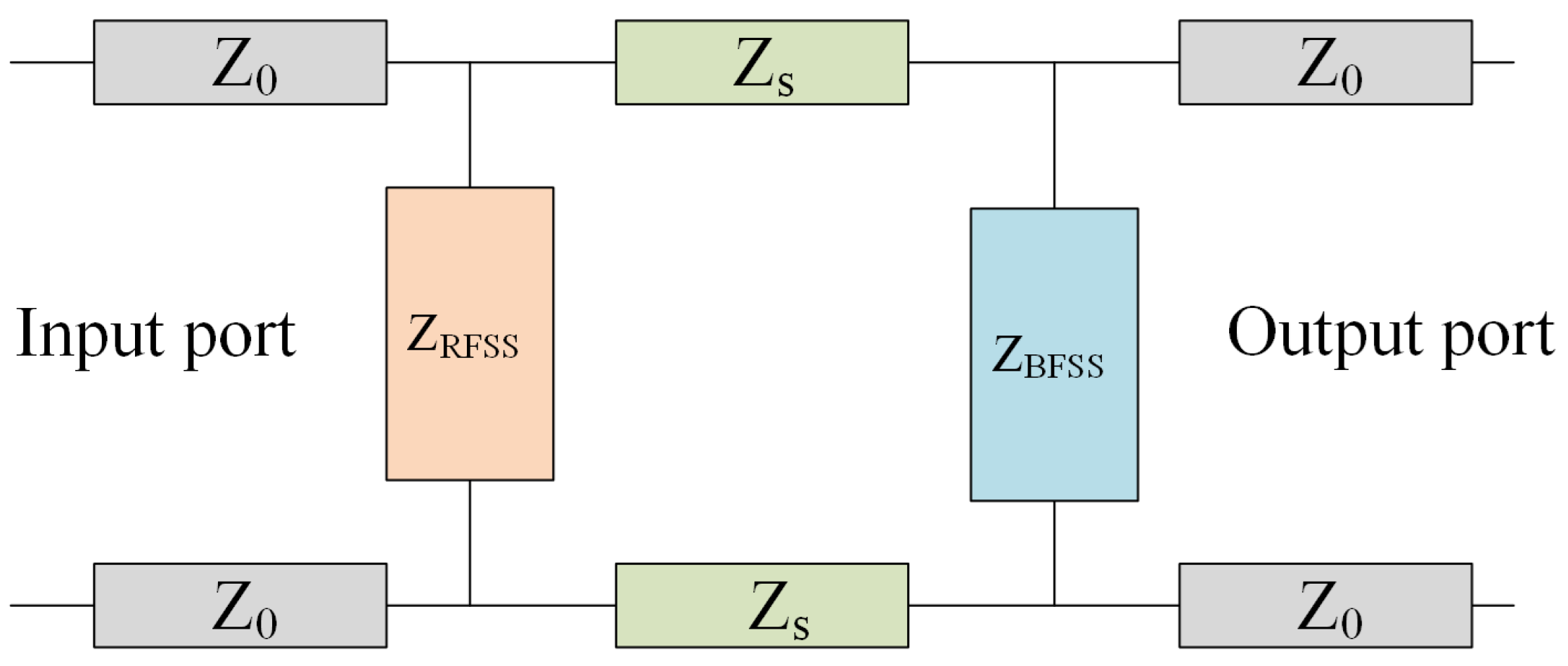
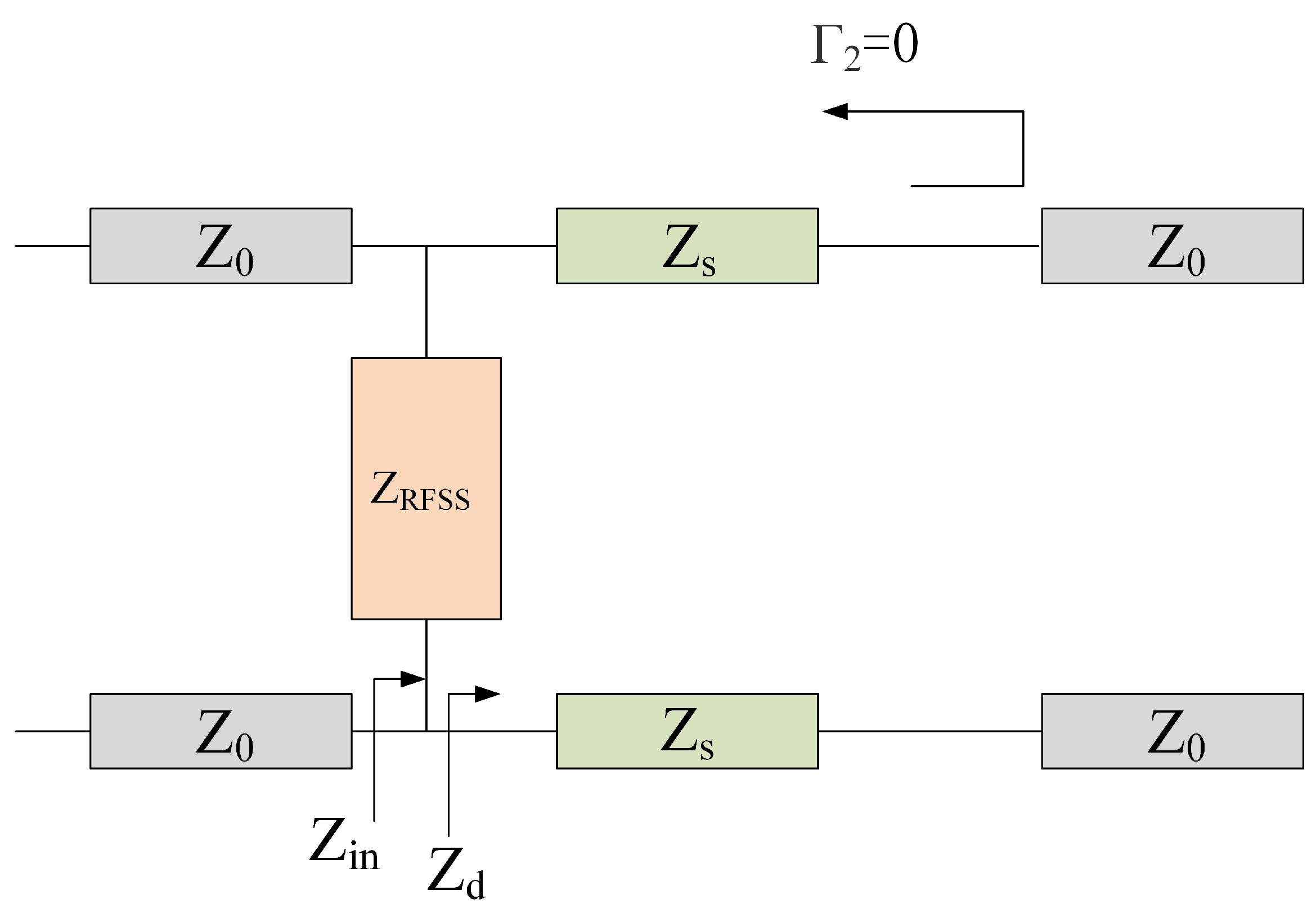

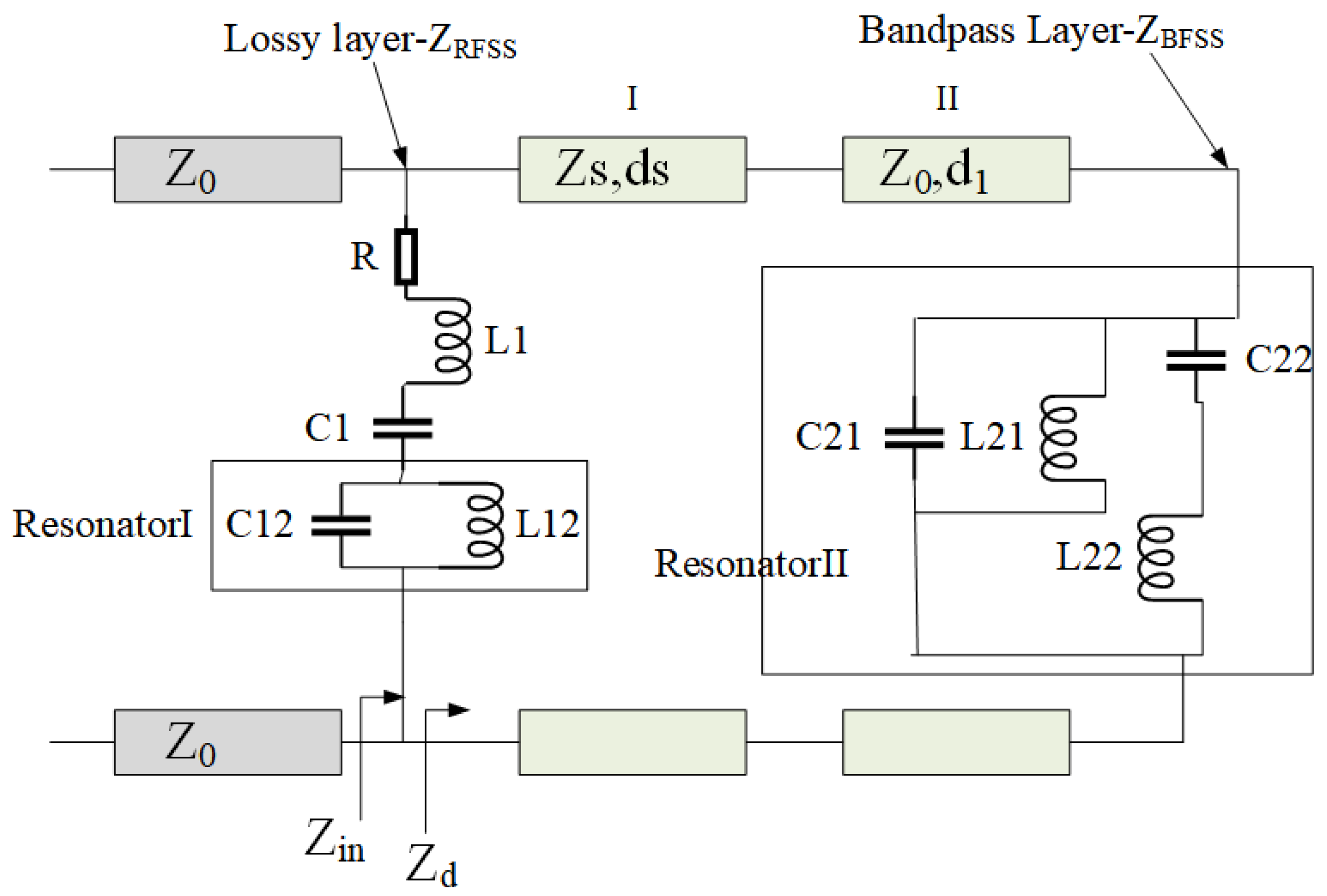


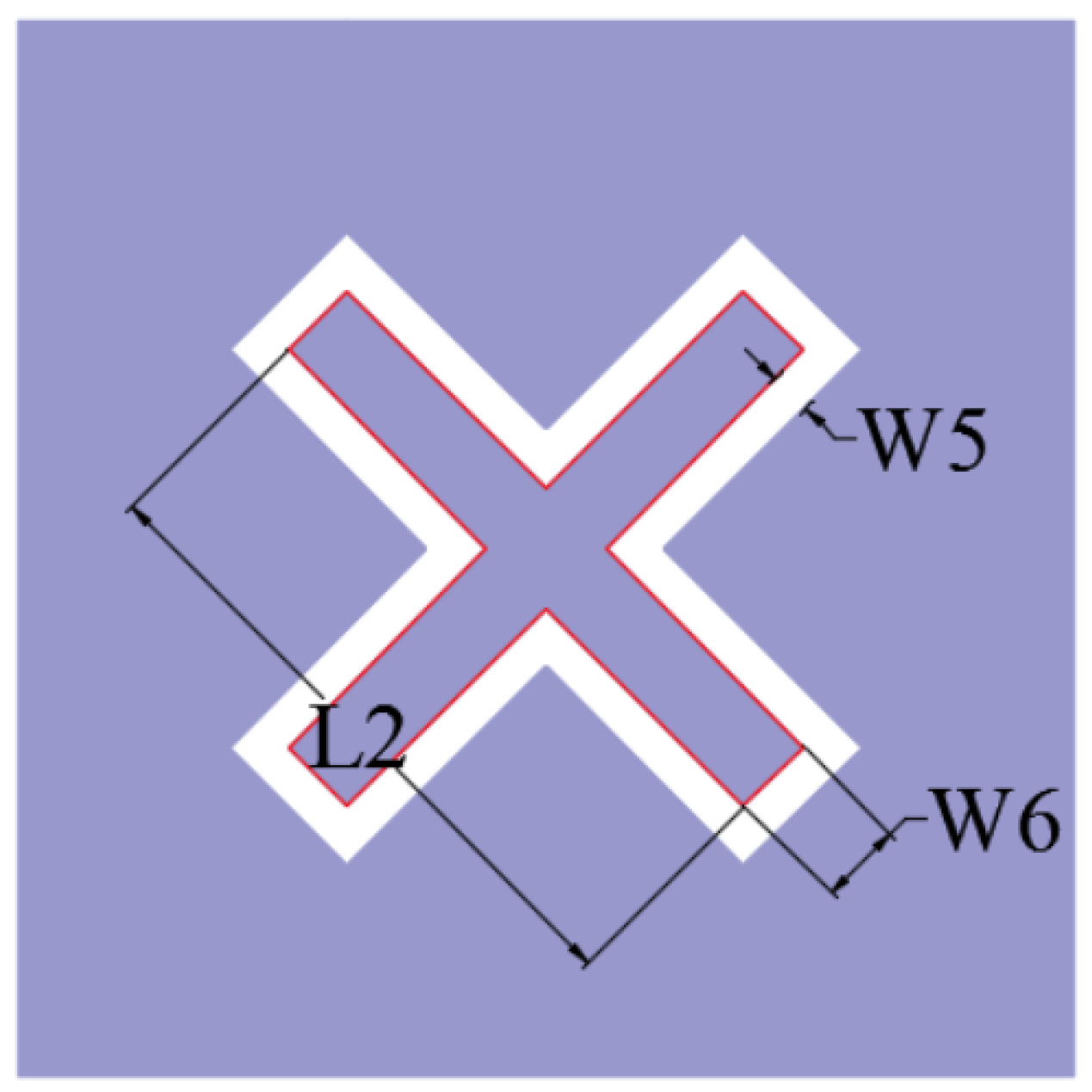

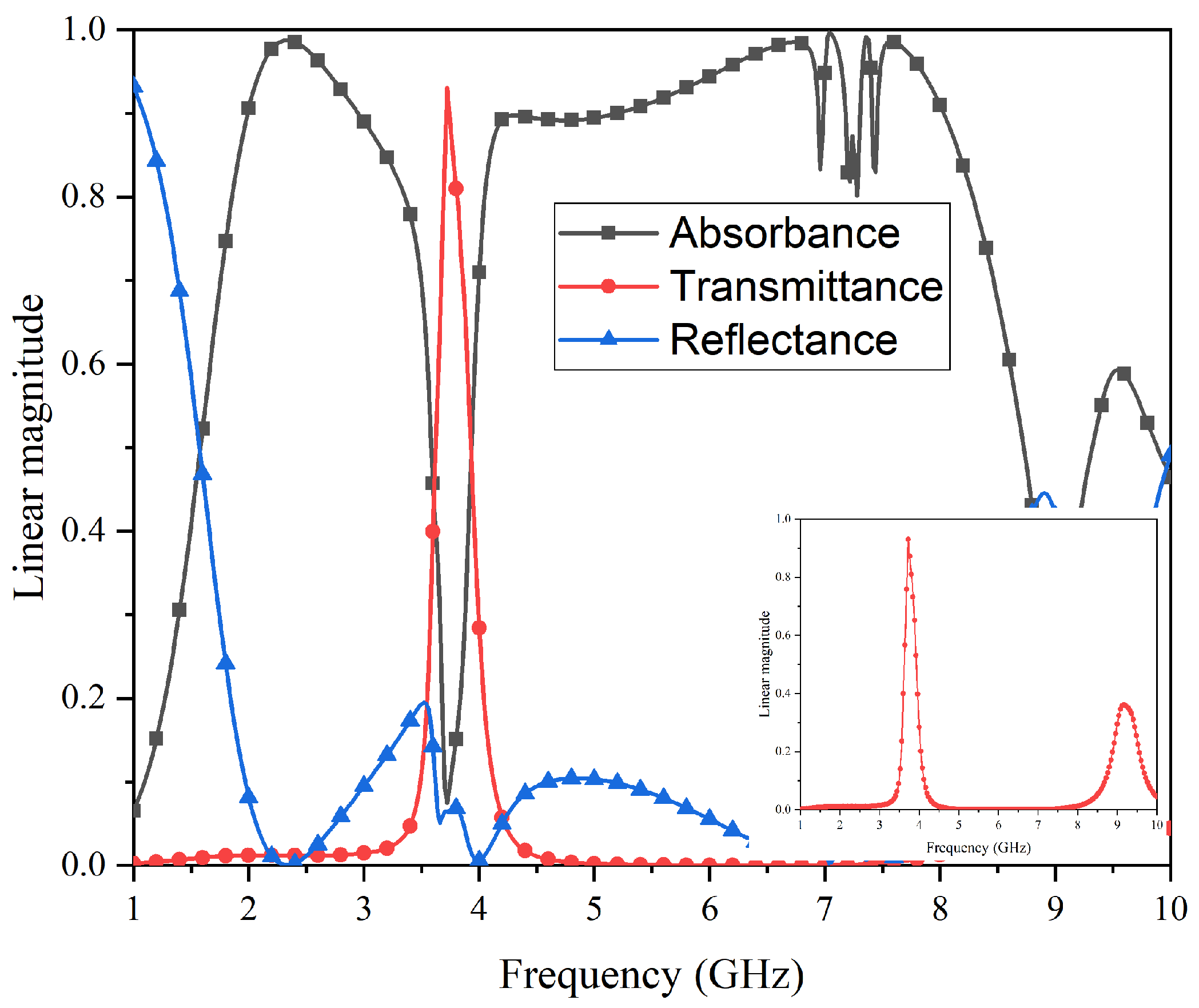

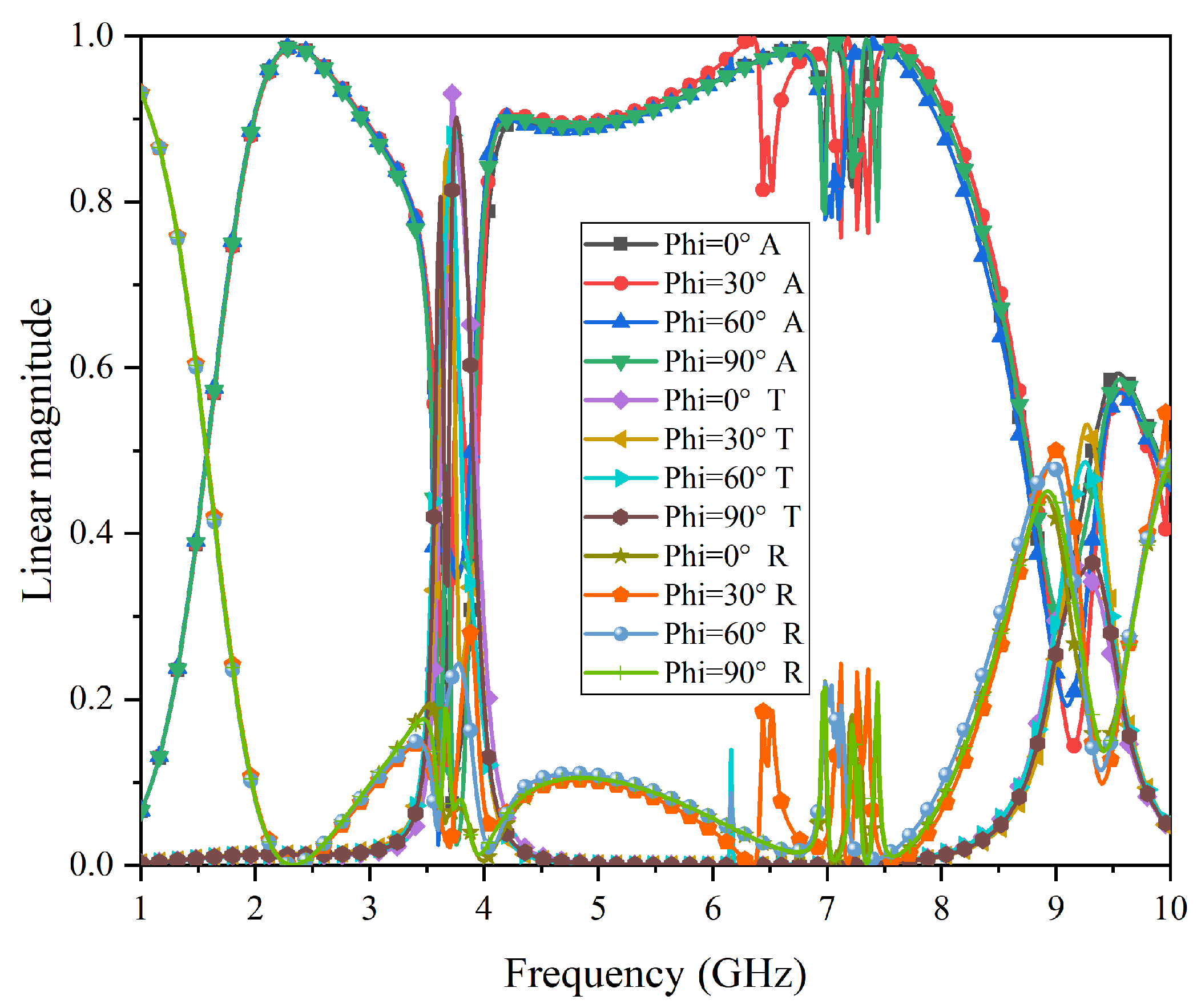
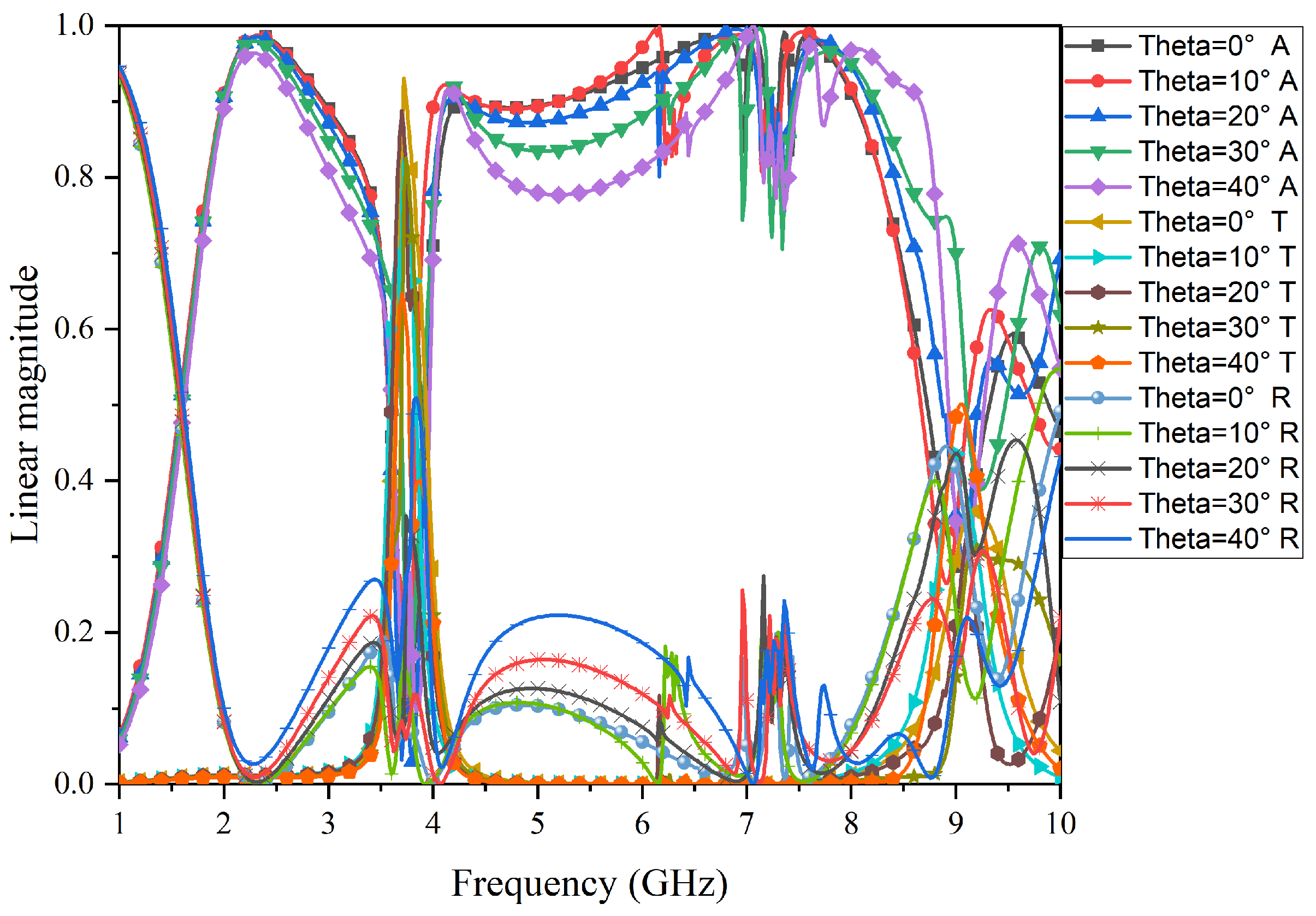
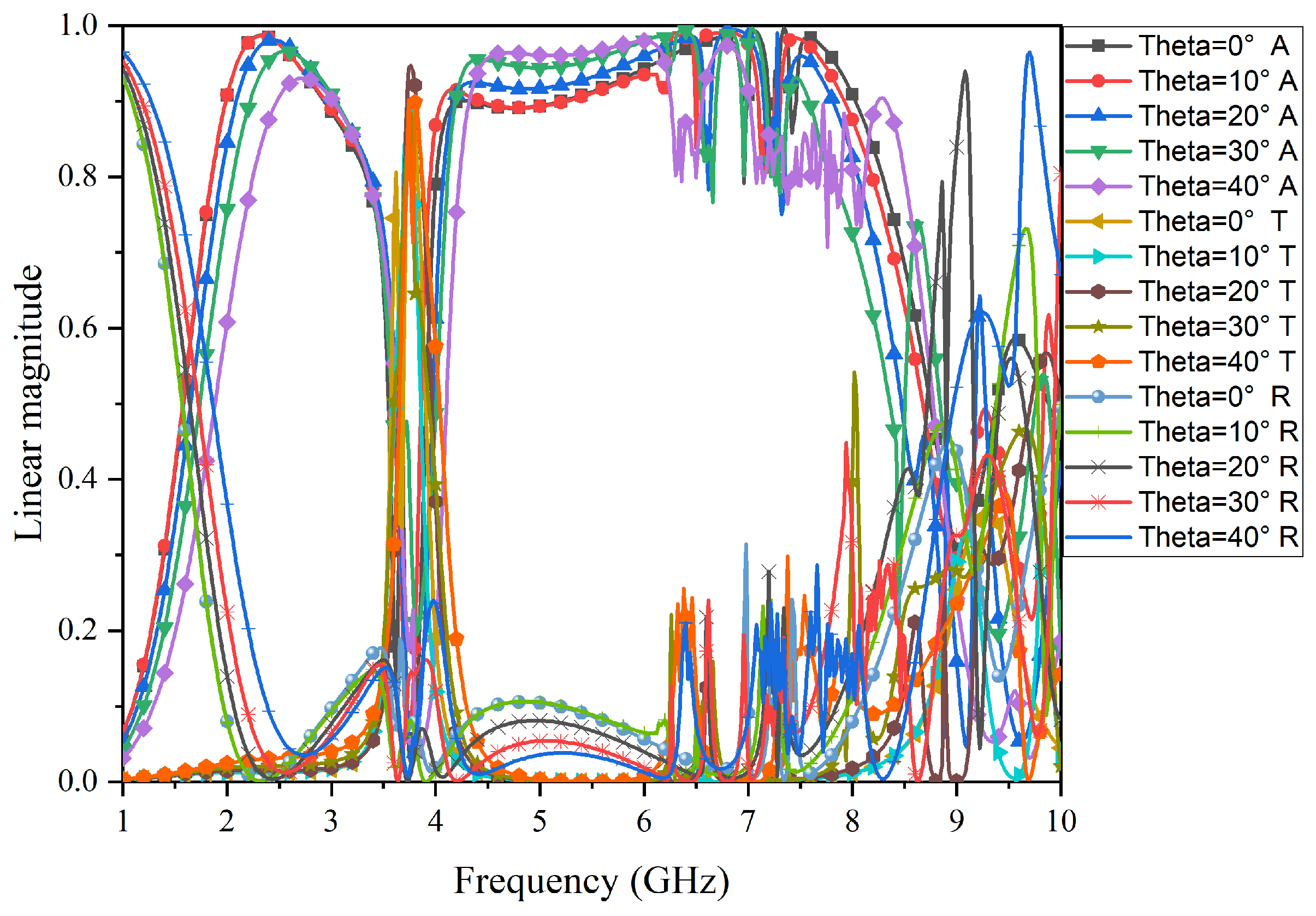
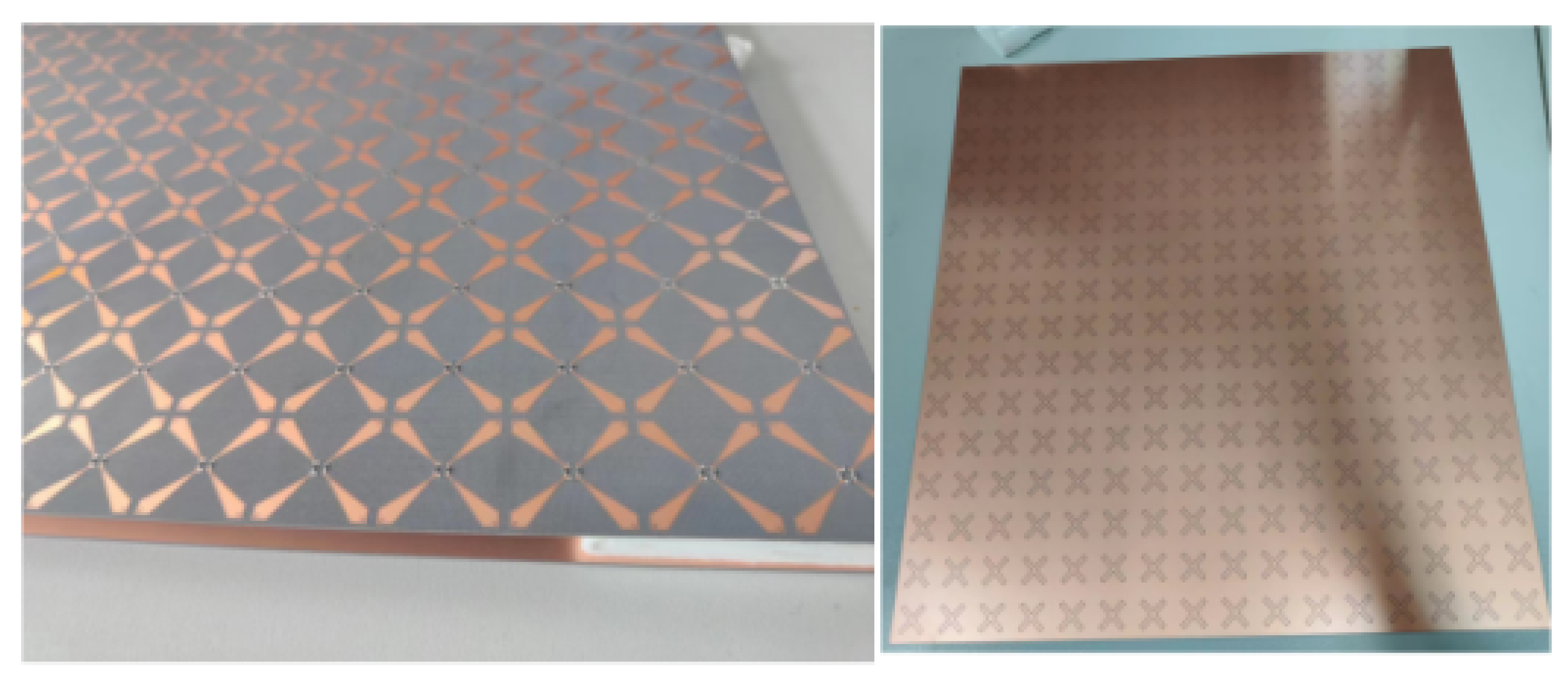
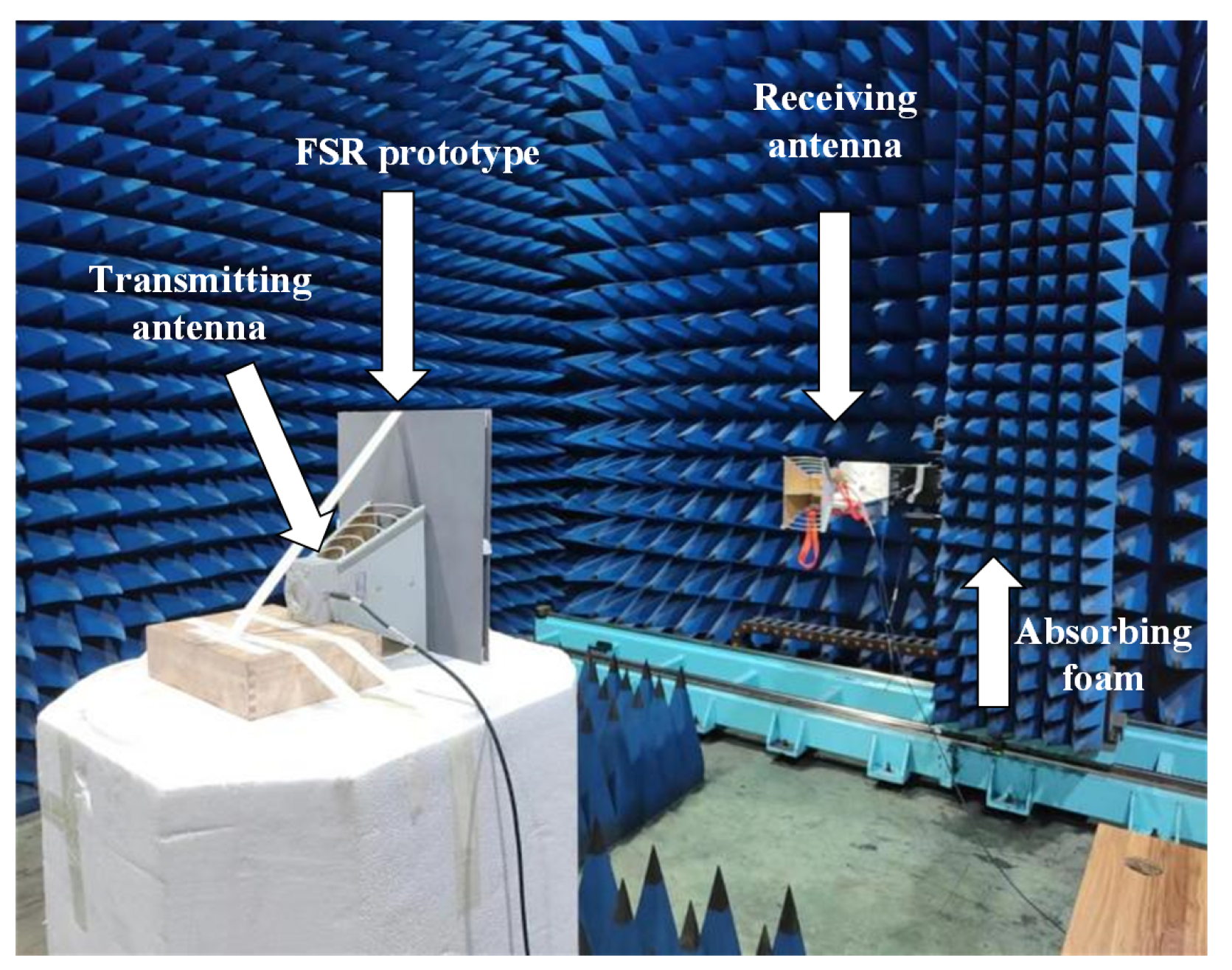
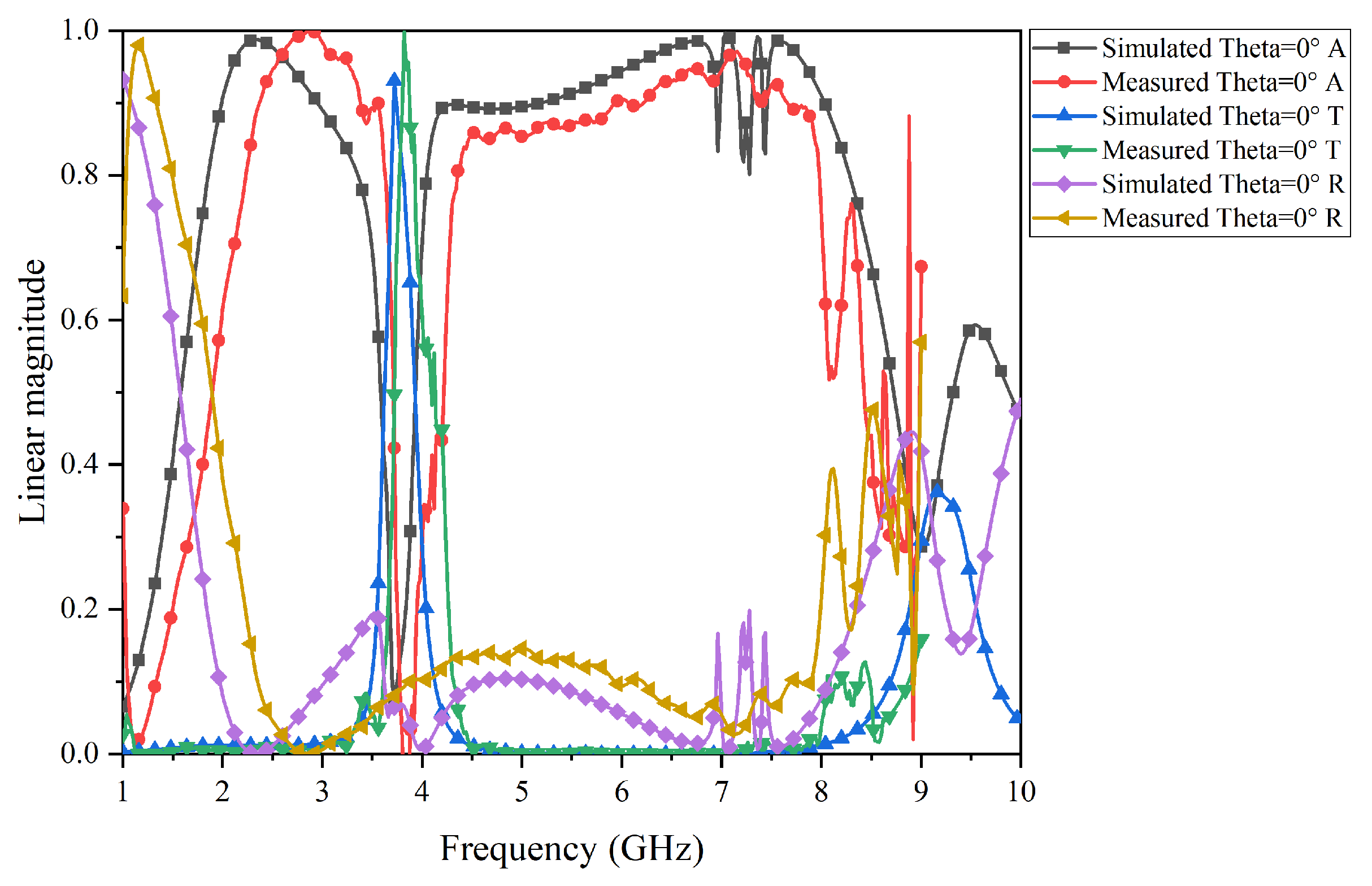
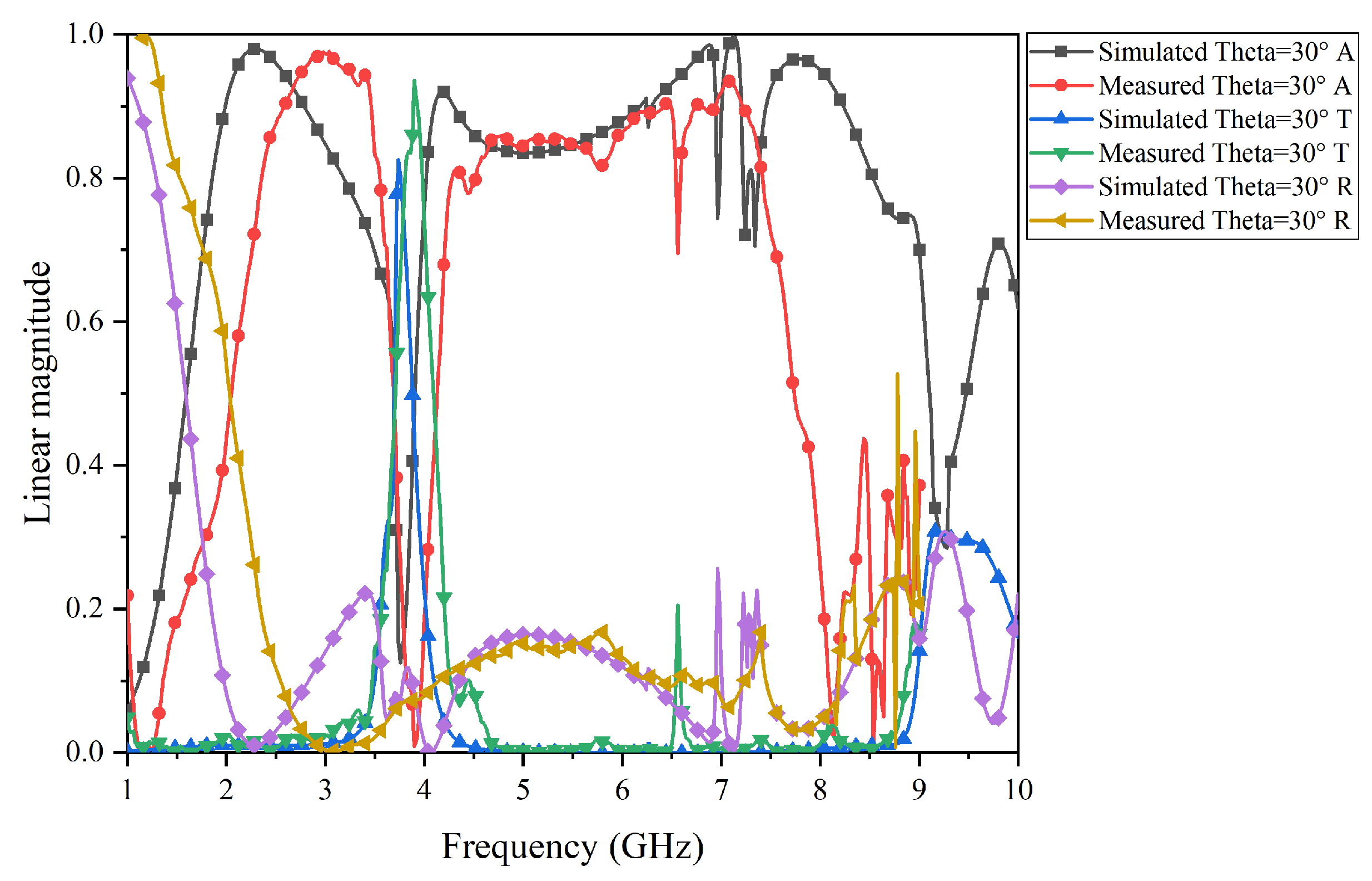


| Parameter | Value (mm) | Parameter | Value (mm) | Parameter | Value (mm) |
|---|---|---|---|---|---|
| L | 25.0 | 0.2 | 3.0 | ||
| 3.0 | 0.4 | 15.3 | |||
| 1.0 | 2.0 | 1.6 | |||
| 0.1 | 0.5 |
| Ref. | Absorption Bandwith | Transmission Rate | Unit Cell | Polarization | Angle |
|---|---|---|---|---|---|
| [19] | 3.68–7.26 GHz (65.5%) 12.30–14.20 GHz (14.3%) | 9.6 GHz (97%) | 0.48 | Dual | N.A. |
| [20] | 1.92–3.73 GHz (64.1%) 7.41–9.34 GHz (23.0%) | 5.74 GHz (91%) | 1.15 | Dual | 35° |
| [21] | 4.00–8.50 GHz (72.0%) 11.20–14.60 GHz (26.4%) | 10.25 GHz (95%) | 0.48 | Dual | 30° |
| [22] | 6.26–9.58 GHz (41.9%) 11.46–14.06 GHz (20.4%) | 10.4 GHz (88%) | 0.62 | Single | 30° |
| [23] | 1.83–4.06 GHz (75.7%) 4.56–6.44 GHz (34.1%) | 4.3 GHz (97%) | 0.23 | Dual | 40° |
| [24] | 2.57–4.98 GHz (63.8%) 8.32–8.8 4GHz (6.0%) | 6.6 GHz (90%) | 0.44 | Dual | 45° |
| This paper | 1.86–3.35 GHz (57.2%) 3.99–8.28 GHz (69.9%) | 3.72 GHz (93%) | 0.31 | Dual | 40° |
Disclaimer/Publisher’s Note: The statements, opinions and data contained in all publications are solely those of the individual author(s) and contributor(s) and not of MDPI and/or the editor(s). MDPI and/or the editor(s) disclaim responsibility for any injury to people or property resulting from any ideas, methods, instructions or products referred to in the content. |
© 2024 by the authors. Licensee MDPI, Basel, Switzerland. This article is an open access article distributed under the terms and conditions of the Creative Commons Attribution (CC BY) license (https://creativecommons.org/licenses/by/4.0/).
Share and Cite
Li, Y.; Zhong, Y.; Wang, M.; Chen, K.; Ren, P.; Xiang, Z. A Miniaturized and Highly Stable Frequency-Selective Rasorber Incorporating an Embedded Transmission Window. Micromachines 2024, 15, 980. https://doi.org/10.3390/mi15080980
Li Y, Zhong Y, Wang M, Chen K, Ren P, Xiang Z. A Miniaturized and Highly Stable Frequency-Selective Rasorber Incorporating an Embedded Transmission Window. Micromachines. 2024; 15(8):980. https://doi.org/10.3390/mi15080980
Chicago/Turabian StyleLi, Yi, Yuxi Zhong, Minrui Wang, Keqing Chen, Peng Ren, and Zheng Xiang. 2024. "A Miniaturized and Highly Stable Frequency-Selective Rasorber Incorporating an Embedded Transmission Window" Micromachines 15, no. 8: 980. https://doi.org/10.3390/mi15080980
APA StyleLi, Y., Zhong, Y., Wang, M., Chen, K., Ren, P., & Xiang, Z. (2024). A Miniaturized and Highly Stable Frequency-Selective Rasorber Incorporating an Embedded Transmission Window. Micromachines, 15(8), 980. https://doi.org/10.3390/mi15080980





